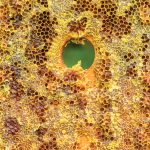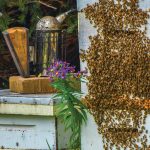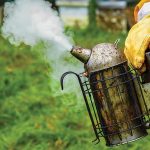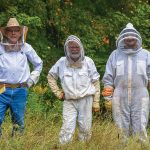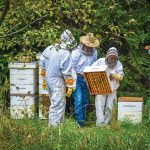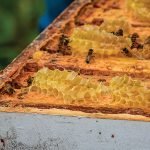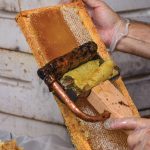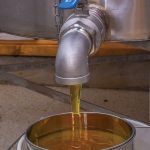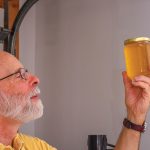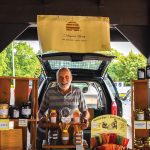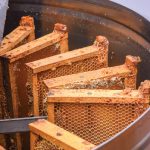Meaford-based Sunnyside Honey wrings golden sweetness from the Escarpment with the help of thousands of bees
by Emily Worts
photography by Doug Burlock
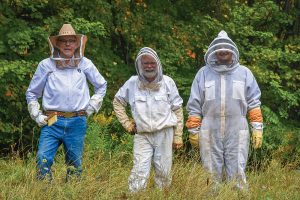
It’s a familiar backdrop for many of us: craggy rock outcroppings spotted with gnarly cedars stretching down to the familiar waters of Georgian Bay. This is the beloved Niagara Escarpment, which frames our lives in Southern Georgian Bay. But there is more to this backdrop, and you have to pay attention to notice. Tucked into the bushes, trees and along the back fringes of hay fields are hundreds and hundreds of rectangular boxes, painted a myriad of colours, lined up like sentries watching over this land, almost as if ensuring its tranquility. Yet there is a dismaying amount of busy-ness going on in and around these boxes.
Richard Elzby has made a business out of this busy-ness. He owns 35 of these small pine beehives and cares for the thousands of bees who call them home. According to Elzby, owner of Sunnyside Honey, Grey and Bruce counties boast more beekeepers than anywhere else around.
“There are many, many beekeepers in the Grey-Bruce area,” he says. “We don’t have the most hives, but we have the most beekeepers.”
Why is this area so popular for honey making? It’s simple, says Elzby: “The hills and Escarpment make really good-tasting honey.”
Honey is considered by many as a ‘miracle’ substance, often referred to as ‘liquid gold’ or the ‘nectar of the gods.’ This wild food is not only a sweet treat but has endless therapeutic qualities, including antibiotic, antifungal, antiviral, antiseptic, anti-aging and anticancer properties.
Elzby, 70, has been tending bees and making honey for 15 years.
“The reason we started keeping bees was that our beekeeper passed away,” says Elzby of the man he once bought honey from. “We couldn’t find any honey that tasted like his; it was so mellow.”
Then, for Christmas of 2002, Elzby’s children gifted him the Beekeeper’s Bible, an almanac billed as the ultimate guide to the practical essentials of beekeeping.
“It’s as thick as the Bible,” says Elzby, who still references the book, among stacks of others in his bee library. “I started reading it that winter, and the following spring I went to Grey-Bruce Bee Supplies and bought my hive products.”
Each year, Sunnyside Honey produces 3,500 pounds of honey, approximately 100 pounds from each hive. Only two of Elzby’s hives reside on his waterfront property in Meaford; he relies on friends and growers from the area to house the rest.
“Beekeepers may have a farm or they may not,” he explains. “To get the diversity of flavour I have my hives on five farms. They are the organic properties of produce vendors from the Meaford Market.”
The relationship between farmer and beekeeper is a common one and a symbiotic one as well: beekeepers need the space to rest their hives and room for their bees to forage, while famers need the pollinators.
Sunnyside Honey is not certified organic but it may as well be. The properties Elzby keeps his hives on use organic practices and he makes sure to stay as far away from commercial farming activities as possible. “I’m miles away from any kind of operation where they are spraying,” he says. Coincidentally, the locations where Elzby has decided to place his hives also happen to boast the most breathtaking scenery. With the combination of toxin-free forage and hives nestled in the bush up against the rocky Escarpment, it is not surprising that his honey is some of the best around.
“There is every kind of wild fruit tree you can think of,” he says of the landscape his bees thrive on. “And all around the farms have hay. When it’s ploughed in June there is an under-storey of alfalfa and clover. The bees love it.”
The honey loves it, too. Elzby’s customers at the Meaford and Owen Sound farmer’s markets tell him they have never tasted anything like his honey.
Sunnyside honey combines nectar from wildflowers, wild fruit, clover, alfalfa and trefoil, which Elzby describes as a prolific small yellow snapdragon, as big as the tip of your baby finger.
“I don’t know what gives the honey its special taste,” says Elzby. “The trefoil may have something to do with it. It’s really good-tasting honey and it’s golden in colour.”
Sunnyside Honey also sells creamed honey, honeycomb, honey sips (one teaspoon of plain or flavoured honey – think root beer and piña colada – packaged in a plastic straw) and honey-oatmeal soap.
In Elzby’s world, honey is everywhere. Eighteen frames of honeycomb sit in two large boxes under the breakfast bar in his Meaford home. His wife, Jane, is not thrilled, but the honeycomb needs to stay warm until Elzby finds the time to cut it into hundreds of smaller pieces for the Owen Sound Market.
“Honeycomb is totally perfect,” says Elzby. “It is honey spun by the bees; there is no human interference.”
He sells the honeycomb to parents who spread it on their children’s sandwiches, to foodies who will arrange a few of the hexagons on their hors d’oeuvres, and to the health conscious who take a teaspoon – wax and all – and swallow the sweetness down, along with all of its health benefits.
It’s not just locals who think Grey-Bruce beekeepers produce world-class honey; Elzby is a member of a local beekeeper’s association that was recently approached by a group of Chinese businesspeople who wanted to buy up their entire honey inventory. The area’s producers declined the offer, wanting to save product for their local patrons. Elzby did, however, invite one Chinese family to his home to learn more about his operation.
“They bought a case of buckwheat honey, a box of my wife’s honey oatmeal soap, regular honey, everything,” he recalls. “They came and spent the day with us. It was such an amazing day. Only one out of five of them spoke English; their daughter translated everything for us. I was elated after they left.”
Chances are the guests were elated, too. Elzby’s love of and fascination with bees, and all that surrounds them, is undeniable. He can’t resist rhyming off fascinating bee facts.
“Did you know one bee makes 300 trips a day from flower to hive? They fill up their two stomachs and take it back to the hive,” he enthuses. “And the queen lays 2,000 eggs a day to support a nice, plump beehive of about 50,000 bees in the peak of summer.”
It’s no wonder the intricate life of bees and the environment they live in continue to pique Elzby’s curiosity. Whether its pollinating the planet or putting honey on our toast, it is important for us all to recognize the work bees do. The next time you put a teaspoon of honey in your tea or spread a little on your toast, keep in mind that 1,152 bees need to travel about 180,000 kilometres (the equivalent of four-and-a-half times around the earth) and visit 4.5 million flowers to fill one 16-ounce jar or make 1 pound of honey. That deserves some respect.
These are complex colonies of order and precision; highly functioning mini-worlds that produce that sweet elixir we humans have enjoyed since the beginning of time. And the beekeepers who bring this nectar to us deserve our respect as well. Without them what would we take to soothe our throats, sweeten our lives and remind us just how very connected we are to the natural world around us? ❧






